Repositioning NSDL for Next Generation
A dissemination site for progress and news on NSDL's grant from the National Science Foundation: Repositioning NSDL for the Next Generation of Digital Learning (DUE #1144560). Period of Performance: October 1, 2011 through September 30, 2013.
The National Science Foundation provided transitional funding for NSDL in Fall 2011, via a two-year grant to develop and expand key elements of recent NSDL work to additional cross-network partnerships, including Pathways and other NSDL partners, for long-term sustainability.
Key work elements:
Transitioning NSDL technical infrastructure to UCAR
Technical infrastructure for NSDL resided at Cornell University from 2001-2011. Current Next Generation funding has enabled the transition of those systems to the University Corporation for Atmospheric Research (UCAR), the institutional home of the NSDL program. This work was accomplished from October - November 2011.
The NSDL technical operations team at UCAR continues de-bugging and documenting, assuring the stability of NSDL systems and services hosted on a combination of cloud-based Rackspace servers and UCAR servers.
Transitioning library collections
Collection building activities include building new and enhancing existing collections along these three parameters:
- Learning Application Readiness (LAR) collection building - implementing criteria, guidelines, and best practices for developing collections of resources and metadata cataloged to LAR metadata framework to programmatically disseminate NSDL metadata and usage data to multiple communities of practice via their platforms/portals/systems.
- Alignment to education standards - comprehensively growing the NSDL Math Common Core collection, developing a collection of STEM-relevant English Language Arts (ELA) Science & Technical Common Core standards-aligned resources, and preparing and adapting processes to address the Next Generation Science Standards, scheduled for release in Fall 2012.
- Paradata – implementing the exchange of usage data about digital resources to/from NSDL and Pathways partners, and from NSDL to the Learning Registry project, and other partners
Redefining NSDL network effects
- NSDL STEM Exchange can be considered as the interchange mechanism for NSDL STEM content, data, and services to external efforts such as the Learning Registry and other partners, with potential to develop into an additional NSDL brand
- Leverage the STEM Exchange pilot work from 2010-11 as a demonstrator for Learning Registry activity and partnerships
- Continue work with Learning Registry primary partners (Dept. of Education, Dept. of Defense, and SRI) to assist other content and data partners in connecting to Registry technology, as well as resolving issues of paradata integration, analysis, and adoption barriers
- Further define how NSDL can serve the broad community of NSF grantees in contributing their metadata and paradata to Learning Registry via NSDL
Pulling it all together: Creating a Production Network
In implementation, this work is resulting in the development of a scalable production network of STEM content and services to educator communities of practice via systems, portals, and platforms that they use, while still providing access to exemplary STEM resource collections and services to individual end users at nsdl.org.
While the overall education scope of NSDL collections continues to be K16 and beyond, the production network grant work is focused on K12, since standards-alignment is a major component of the work.
The partnered work takes place entirely in the first year of the grant: October 1, 2011 through September 30, 2012.
Project partners
Collection building and services partners on the NextGen project include:
- AMSER/Internet Scout; University of Wisconsin
- ChemEd Digital Library; University of Wisconsin
- Climate Literacy and Energy Awareness Network (CLEAN); TERC
- ComPADRE Physics & Astronomy Digital Library; American Association of Physics Teachers (AAPT)
- Middle School Portal Math & Science Pathways (MSP2); Ohio State University
- Science and Math Informal Learning Educators (SMILE); Lawrency Hall of Science, University of California, Berkeley
- TeachEngineering of the Engineering Pathway; University of Colorado
- Teachers’ Domain/PBS LearningMedia: WGBH/PBS
These partners were selected based on the capacities of their existing and developing metadata and processes to support LAR collection building, standards-alignment, and paradata collection building, and their ability to rapidly collaborate in these areas for this effort.
MSP2 and Internet Scout are providing services to support the collection development and contribution work of the other partners, and to assist NSDL in these ways:
- MSP2 is developing guidance for the standards alignment process; conducting gap analysis on content and resource types for NSDL Math Common Core (MCC) collection; building subject hierarchy for applicable English Language Arts (ELA) Science & Technical Standards; identifying and aligning resources to MCC and ELA; and providing process support and documentation
- Internet Scout is collaborating with NSDL and MSP2 on standards-aligned collection building and cataloging; conducting gap analysis of the overall NSDL collection to identify areas of need; conducting weeding activities as a curation practice over the NSDL collection; and contributing to developing processes and best practices for paradata exchange and monitoring between NSDL and Learning Registry networks.
Evaluation partners
Evaluation activities for the NextGen work are shared by: the Metiri Group - conducting evaluation for the project on Math Common Core resources as they are disseminated through the broad NSDL production network. Valerie Williams, of UCAR, is conducting production network evaluation on the NextGen project.
Policies and Guidelines
A revised Collection Policy for NSDL as well as helpful guidelines and rubrics for collection builders are a result of NextGen project:
NSDL Collection Policy (Jan 1 2012)
NSDL Collection Development Blueprint (Jan 1 2012)
NSDL Resource Quality Checklist (Jan 1 2012)
NSDL Resource Metadata Rubric (Jan 1 2012)
NSDL Annotation Metadata Rubric (Jan 1 2012)
NSDL Paradata Metadata Rubric (Jan 1 2012)
NSDL Weeding Plan 2012 (v.1) (Mar 2012)
These are also available from nsdl.org/about/policies
Draft guidelines in development for Common Core collection building
The Middle School Portal team is working with NextGen partners to enhance and expand the NSDL Math Common Core collection, and to create an English Lanugage Arts for Science and Technology Standards collection. The following documents are emerging guidelines for these collection building efforts.
Math Common Core Collection Development - Draft (Apr 17 2012)
English Language Arts Common Core Collection Development - Draft (Apr 17 2012)
This site is an outcome of work supported by the National Science Foundation under the following grant awards:
- #1144560 - Repositioning NSDL for the Next Generation of Digital Learning, University Corporation for Atmospheric Research; PI: Kaye Howe
- #0840858 - Center for Sustaining Broader Impacts; University Corporation for Atmospheric Research, NSDL Resource Center; PI: Kaye Howe
- #0840744 - NSDL Technical Network Services: A Cyberinfrastructure Platform for STEM Education; Cornell University, University of Colorado, University Corporation for Atmospheric Sciences, Digital Learning Sciences / Integrated Information Services; PI: Dean Krafft
Project Accomplishments
Periods of Performance
Project timeline: work elements are divided into 2-month "sprint" time periods, starting with February/March 2012 as Sprint 1, for FY 2012.
Year 2: FY 2013 - October 1, 2012 - September 30, 2013
Year 2 - October 2012
- Summary of Year 1 highlights
- Year 2 workplan:
- continuing Common Core Mathematics & ELA associated collections and paradata collections provision with partners; working on improving UI display features for Math Common Core collection
- refining technical plan for Year 2: potential for refinement of OAI harvest/ingest process for increased agility, reliability, functionality; personalization features
- business planning activity/consultation during Q1 October - December with focus on customization and content services provision
- funding opportunties exploration and investigation
August - September 2012 - Sprint 4 (end Year 1 - FY 2012)
Project Management/ Collections
- Next Gen partners continue to complete their collection building efforts, adding new paradata, annotation, and resources
- See visual on Next Gen collections building
Technical
- New features released: Faceted search and Browse-by-standards. Users can narrow search results by education level, resource type, subject, audience, or standards. Select from following standards sets: Common Core Math and ELA standards, NSES, AAAS Benchmarks (1993 and 2008), Geography for Life. See example.
Communications
- Focusing on annual project reporting for NSDL grants
- Next Gen collaboration teleconferences: Starting in October 2012, we'll move to monthly partner teleconferences (instead of biweekly) on the second Wednesday of each month
June - July 2012 - Sprint 3
July
1. NSDL hosted a NextGen Partners meeting in Boulder on July 23-24 for productive discussion for educational trends (K12, higher education, informal education) relevant to NSDL's future business planning, and exploration of combined service possibilities across the NSDL partnership.
Subsequent to the meeting, NSDL has been engaged in analyzing and refining possibilities for the suite of NSDL services, working to match those services to audiences and markets. Milestones calendar development is underway, along with business model development; exploration of funding opportunities; and evaluation of NSDL NextGen Production Network activities over the last year.
Potential service categories:
- digital library management and software services (digital discovery system, NSDL Collection system, jOAI, CWIS, reveiw tools by partners)
- technology operations services (repository search server and interoperability operations, catalog management operations, custom e-learning environments and applications, Strand Map Services API, Search API, weeding application, vitality services, metadata frameworks)
- standards of practice and excellence services (Learning Application Readiness (LAR) training; review services, standards alignment services)
- access to NSDL (portal services, repository search API, OAI Data provider)
2. Educational trends summary - K12 (Julie Evans, Project Tomorrow):
- Proliferation of technology tools ('enablers'), especially moble device use in daily life (online learning, social media for collaboration, games, mobile learning, Do-It-Yourself learning (DIY)
- Personal use of mobile devices drives valuing of technology by teachers, librarians, principals and district administrators
- Games - new class of intelligent adaptive learning - educational technology that captures student decisions within instructional technology programs, adjusting student learning path appropriately, enhancing individualized learning paths, and providing teachers with real-time data to inform instruction
- challenges for professional development for teachers, for assessment
- Student Digital Advance Team - 8th graders on leading edge of desire for personalized, tech-based learning in their education; adopting and adapting emerging tech for learning; frustrated with unsophisticated use of technologies in schools; persistent digital disconnect with adults; lack a sense of relevancy in their education; consider personal learning goals to be just behind good grades and getting into college, when defining 'success' for their schoolwork.
- Vision for personalized student learning includes social-based learning, untethered learning, digitally-rich
- Importance of K20 continuum, as K12 students rise to college education level.
Sticky wickets:
- students don't believe test scores reflect what they really know
- evaluation of the academic value of student-created content
- measurement of the impact of DIY and informal/out-of-class learning, including home schooling
- measuring student 21st century skills vs. content knowledge
Teachers:
- 56% want access to vetted, grade level appropriate, content-specific resources
- 33% want video clips of teachers demonstrating use of digital contnet in content areas
- blended learning trend: teacher adoption of blended approach using direct instruction, student directed learing, and use of tech tools to support both teachers and students
- most important factors for evaluating quality of digital content for classroom use: teacher-created resources, free content, referral by a colleague
- alignment/association of content to curriculum, standards
Pain points:
- Cutting costs while funding adequate technology in schools
- integration of technology and digital resources in classrooms
- implementation of Math Common Core standards into curriculum
- concern with evaluation of student performance re: Math Common Core practice recommendations
- ensuring quality of resources
- lack of technology implementation training for pre-service teachers
- methods for addressing informal, after-school, and home schooled learner needs
2. Higher ed trends (Richard N. Katz Consulting)
- Crises in: competiveness; credibility; affordability; business models
- unemployment, student debt
- de-funding by states; rapid rises in tuition; increasing reliance on contingent workforce; low graduation rates
- the new student (free-agent learners)
- disruptive technologies (Siri, simulations, etextbooks, mobile devices, analytics, cloud computing, augmented reality)
- disruptive pedagogies (online education goes mainstream; MOOCs: massive online open courses; flipped lectures; open education
- global talent search and globalization of US universities
- new modes of certification: digital badging, certification for experience; ePortfolios; credit aggregators
- University future depends on ability to adapt; reconsider core business models
- Distance learning and 7x24x365 service model is assumed
- Unbundled education: design (program, curriculum, course); lecture delivery; discussion facilitation; social development; academic resource provisioning; assessment, certification
- Remediation needed at grades 13/14
June
Summer may be here, but we have not been idle! Here are just a few things accomplished and coming up for June:
Technical
- NSDL Science Literacy Maps (SLM) - with the collaboration of Project 2061 at the American Association for the Advancement of Science (AAAS), the SLM have been enhanced to include new features: the blue Benchmark information bubbles on the maps now contain (where available) additional information tabs for:
- AAAS Assessments
- student misconceptions
- video tutorials on how to use the SLM for new users
- See an example (click on Benchmark "Earthquakes often occur on boundaries..." - grades 9-12)
- Still in development for implementation later this summer:
- NSDL faceted search - ability to fine tune NSDL searches by specific parameters: subject, standards, resource type, audience
- NSDL standards browse - ability to browse for standards-associated resources to specific standards sets: Math Common Core (MCC), National Science Education Standards (NSES); National Geography standards, and AAAS Benchmarks
Communications
Coming up:
- NSDL webinar, Thursday, June 28, 10 am PT, 11 am MT, 12 noon CT, 1 pm ET: Connecting the Dots with Digital Learning: Speak Up 2011 Findings, with Julie Evans, CEO of Project Tomorrow. To request an invite, contact Eileen McIlvain.
April - May 2012 - Sprint 2
Standards cataloging is proceeding well with NextGen partners, and paradata (17,458 records) and annotation (4,115 records) collections are increasing.
Project Management:
- LAR technical documentation (v.1) provided to partners
- Metrics tracking tables implemented by NSDL to track NG project deliverables and to support emerging NextGen Production Network metrics
- Middle School Portal (MSP2) presentations to production network team: drafts of Collection Development Policy for NSDL Math Common Core collection and English Language Arts Science & Technological Standards (6-12) special collection
- Gap fill analysis report generated by NSDL to learn which Math Common Core standards have no resources associated with them in NSDL Math Common Core collection
- Compilation of responses and comments from survey of NextGen partners re: production network metrics. Metrics rated high priority/high feasibility reveised and discussed in teleconference with partners. Revised metrics for production network determined and recorded via project management wiki.
- Partners completed phone calls with NSDL to review Sprint 1 work and plans for Sprint 2 - done
- Partners scheduled calls in May to reveiw Sprint 2 work and plans for Sprint 3 - done
Technical:
- Work completed on LAR metadata to address vocabulary needs for cataloging science resources; definitions completed
- Gap fill analysis report generated by NSDL to learn which Math Common Core standards have no resources associated with them in NSDL Math Common Core collection
- Test website developed to provide new Math Common Core collection browse structure providing more detailed search of MCC standards
- Effort begun to index the whole library based on ASN ID to enable future user search by standard
- Work completed on NSDL Resource Weeding application and management interface
- Technical work completed to enable LAR metadata collections to appear in the NSDL repository Search API, and to filter weeded resources
- Mark up of sample NSDL resource landing page with LRMI and other schema.org rich snippets; assessing potential use by downstream consumers
- Began efforts to incorporate AAAS tutorials and Benchmark-level assessments and misconceptions into NSDL Science Literacy Maps
Communications:
- Planning for June 27 NSDL webinar: Project Tomorrow Speak Up survey outcomes, trends; personalized learning; math instruction
- Planning meetings for July 23-24 partner meeting; project management team meetings
- NSDL Network Update monthly summary (nsdl-all email list) - Subscribe to email list here
- Email lists management
- Collaboration wiki documentation and management
- NextGen partner biweekly calls conducted
- Websites updating, news postings, Twitter and Facebook postings
- Partner contacts conducted (MatDL, TeachingwithData, Mathlanding, MSP2)
Evaluation:
- Refinement of Production Network metrics from survey outcomes
- Planning for teacher focus group activity in June/July: 1) feedback on NSDL Search results UI for improved display of standards-alignment, and 2) focus group and survey planning for teacher feedback on Math Common Core collection use
- Draft report produced by Metiri Group on NSDL STEM Exchange paradata - an initial model of analysis for reporting and understanding patterns of usage of NSDL reosurces aligned to Math Common Core standards by two user communities (CTE Online, Instructional Architect). Will be utilized with other STEM Exchange communities of practice, based on metadata, paradata, and characteristics of communities.
February - March 2012 - Sprint 1
March
Project Management / Collections
- Consultation telecons between Foster/Ginger/Blomer with partners: WGBH, TeachEngineering, SMILE, ComPADRE, Ohio State/MSP2. Early April calls planned with Internet Scout, ChemEd DL, CLEAN
- Presentation on ELA standards by Jessica-Fries Gaither of MSP2 and Beyond Penguins project to NextGen partners and management team
- Decision point: all new collections, whether standards-aligned, LAR, annotations or paradata, need to be submitted to NSDL by August 1 so there is time for NSDL Accessioning Board consideration, which convenes in mid-August
- Decision point: LAR "open collections" concept adopted to address both LAR-like and LAR-compliant collections. Promotes LAR as target for resource quality; apply as guide/best practice for resource selection; fosters a continuum of LARness in NSDL collections.
- Decision point: Reading level indicators in LAR metadata framework: optional field for reading level-grade level indicator; optional free-text description of literacy measure (e.g. which system, such as Fleisch-Kincaid)
- Kim Lightle will communicate with all partners on standards alignment in April to review partner plans, assess needs, provide support
Technical
- LAR Best Practices draft is nearing completion; catalogig to LAR has begun
- Internet Scout expects completion of weeding of 13 subject gateway NSDL collections by mid-April, using new NSDL weeding application
Communications
- Quarterly NSDL Network community call conducted March 14 – available from NSDL Brown Bag page
- NSDL Network Update monthly summary (nsdl-all email list) - Subscribe to email list here
- Websites editing
- Collaboration wiki documentation and management
- Email lists management
- Partner contacts (EcoEd DL)
Evaluation
- Production Network measures survey finalized and sent to NextGen PIs and NSDL management team; reporting on outcomes and further development of production network measures in late April.
February
Project Management:
- OSU/MSP2 workplan completed
- Scout workplan for Collections/Weeding completed
- Issue identified: display of reading-level indicators in LAR metadata framework. If do, use what conventions, in teaching literacy field?
Technical:
- LAR framework completed
- LAR Best Practices drafted
- First partner paradata received and displayed (ComPADRE)
- Repository Search API and OAI data provider ready for LAR operations
- NSDL resource views and recommendations reports drafted
Communications
- NSDL Pathways updated on NextGen project (Pathways email list)
- March 14 Community call scheduled and invites sent
- Websites editing
- Collaboration wiki documentation and management
- Email lists management
Evaluation
- Production Network measures survey drafted and shared with partners for feedback
January 2012
Project Management
- NextGen Partners meeting in Boulder:
- Introduced Production Network Model
- Statement of Production Network Goals
- List of possible services for NSDL branding
- Network metrics list drafted
- Elements of sustainability drafted
- Recommendations for standards alignment process
- Recommendations for Audience and Scope
- LAR working group reconvenes to develop LAR framework
Technical
- Strand Map Service/Science Literacy Maps migrated to UCAR/Cloud
- Three collections were accessioned into NSDL: Changing Planet, the comPADRE paradata collection, and PRISMS annotations
- NSDL Accessioning Board (NAB) approved accessioning of three new collections: Minds-On Activities for Teaching Biology, TeachSpatial, and TeachSpatial annotations.
Communications
- NSDL Network Update - monthly summary (NSDL-all email list)
- January meeting summary distributed to partners
- Websites editing
- Collaboration wiki documentation and management
- Email lists management
December 2011
Project Management
- NextGen Partners’ workplans drafted by partners in consultation with Foster/Ginger
- Collection documents finalized incorporating input from partners:
- NSDL Collection Policy
- NSDL Collection Development Blueprint
- NSDL Resource Quality Checklist
- NSDL Resource Metadata Rubric
- NSDL Paradata Metadata Rubric
- NSDL Annotation Metadata Rubric
- NSDL Weeding Plan (draft)
- Decision point: Resource URLs vs. collection-provider landing page URLs: include in metadata framework to allow optional partner URL and proposed a strongly visible method in NSDL UI for users to get to partner URL landing pages (e.g.: ‘Learn more about this resource’)
Communications
- Learning Registry Plugfest hosted by NSDL at UCAR. Van Gundy and Weatherley attendance.
- NSDL Network update on new work (nsdl-all email list)
- NSDL Community call (quarterly) conducted December 14 – accessible on NSDL Brown Bag page
- Websites editing
- Collaboration wiki documentation and management
- Email lists management
November 2011
Project Management
- Foster conducted one-on-one conversations with all partners
Technical
- NSDL technical infrastructure migration to UCAR/Cloud completed
- LRMI (Leaning Resource Metadata Initiative) work explored for implications for NextGen work
- Issue identified: Landing page vs. direct resource URLs discussion conducted with partners and solutions are proposed
- Learning Registry: Van Gundy attended Washington DC SETDA meeting for DOD/Dept of Ed Learning Registry project launch announced by Sec. of Ed Arne Duncan; acknowledgement NSDL concept leadership regarding paradata. NSDL STEM Exchange adopted as initial use case for LR.
Communications/community
- Rand personnel make final visit to NSDL to complete NSF evaluation of NSDL program; join NextGen partner telecon
- Collection policy draft, criteria, guidelines, and best practices drafts reflecting LAR principles/characteristics distributed for partner review and input
- Websites editing
- Collaboration wiki documentation and management
- Email lists management
October 2011
Project Management
- Management team established: Howe, Van Gundy, Foster, McIlvain, Kelly, Weatherley, Ginger, Marlino
- NSDL Management team weekly meetings and process established; Susan Foster hired as Project Manager
- Dependencies and workflows developed
- Work priorities:
- Implement production network concept for digital resource use, utility, impact on teaching/learning
- NSDL In service of STEM learning
- Wholesale vs retail approach
Collections Building
- Drafts developed for: revised Collection Policy; rubrics for metadata quality; resource quality; Terms of Use revisio
- LAR Working Group conference call conducted to support finalization of LAR metadata framework
- Technical transition from Cornell to UCAR/cloud services underway; developing technical goals for post-transition, documentation
- Learning Registry - preparation for Learning Registry launch, Nov. 7 (Dept of Ed; DOD Washington DC); NSDL as primary use case for data exchange with Brokers of Expertise, CTEOnline (California) and iCPALMs (Florida) communities of practice
Communications
- UCAR Confluence collaborative wiki spaces established for NSDL Management Team and NextGen Partner workplan tracking and documentation
- Regular biweekly teleconferences established with NextGen partners with initial call on 10-19-2011
- Email lists established for NextGen partner communications (partners + management team)
- Summary report of September LAR2 workshop provided to participants and project partners
- Preparation for Rand visit to NSDL on Nov 2-3, 2011
- Monthly all-Pathways call altered to: NSDL community call occurring quarterly, in final month of quarter
Project evaluation
- Metiri Group for evaluation of standards-alignment collection building with partners
- Valerie Williams (UCAR/GLOBE) to evaluate NextGen production network process
| Attachment | Size |
|---|---|
| NextGen_Highlights_yr1.pdf | 295.89 KB |
Things to look at: diagrams, charts, presentations
What's here:
- New: Year 1 Highlights - download PDF
- New: Collections building metrics at September 2012 and NSDL Metadata formats
- Evolution of NSDL - chart
- NSDL Logic Model - chart
- NSDL Technical Platform - diagram
- NSDL Transition and Technical Platform (September 2011) - presentation to Pathways PIs
Collections building
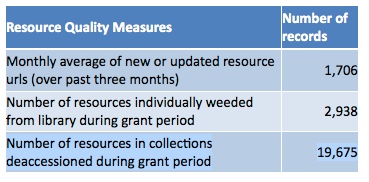
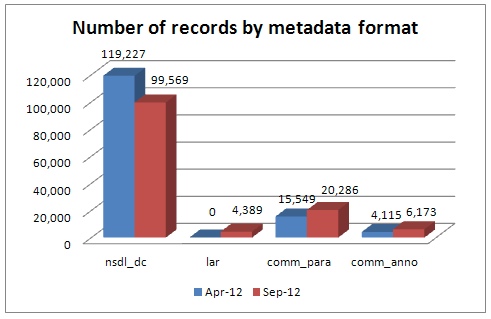
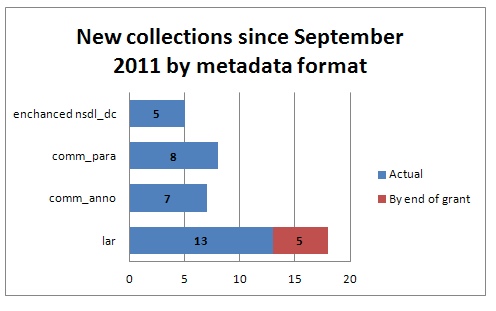
What's a "comm_anno" ??? Learn here - more on NSDL Metadata formats:
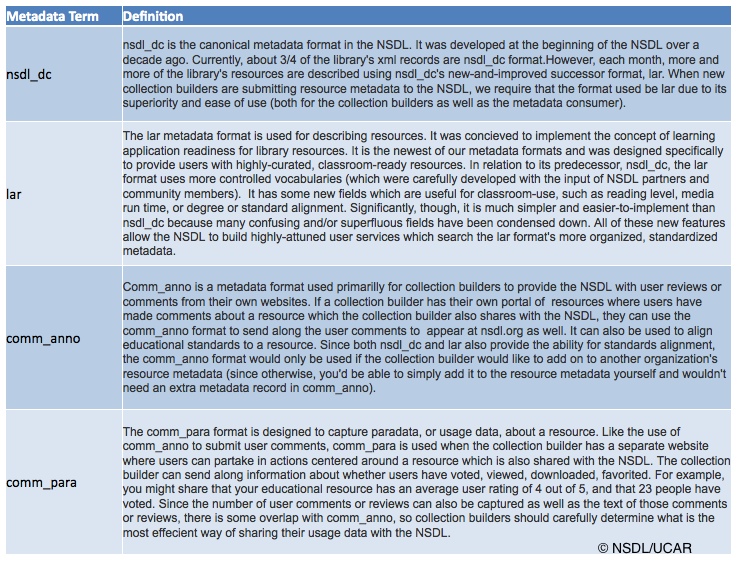
To find out more about NSDL collection contribution and metadata processes, see NSDL Technical Documentation
Evolution of NSDL
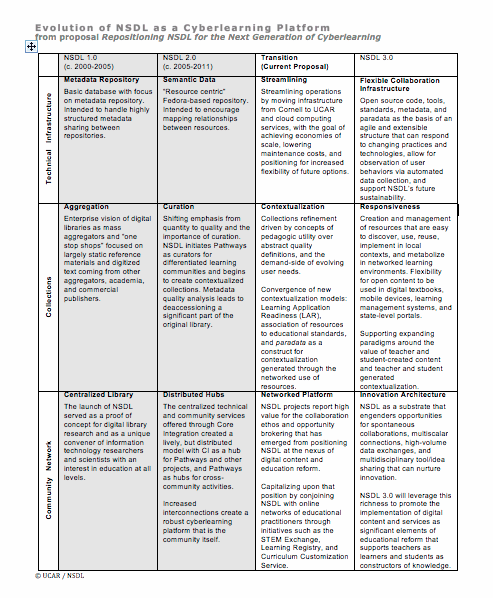
Downloadable PDF of Evolution of NSDL as Cyberlearning Platform
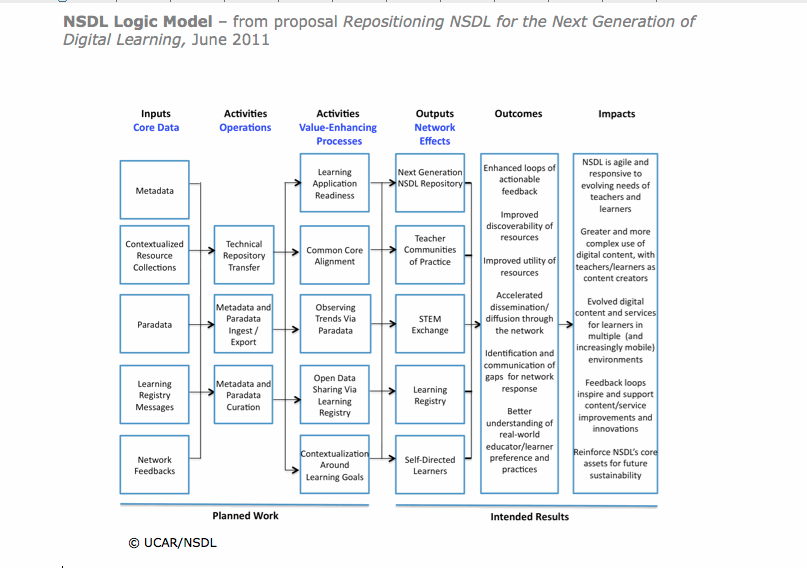
Downloadable PDF of NSDL Logic Model
NSDL Technical Platform
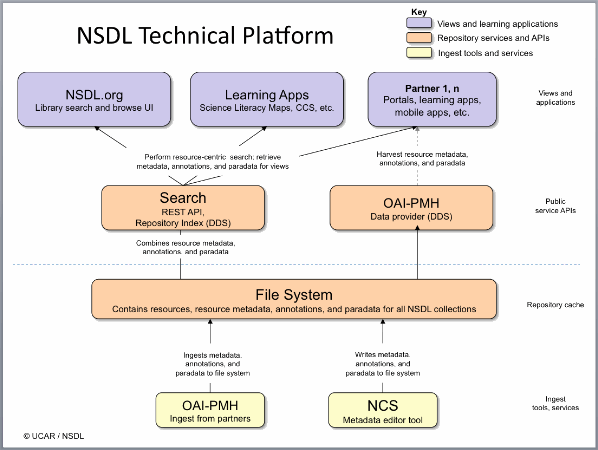
Downloadable PDF of NSDL Technical Platform 2012
Presentation

NSDL Transition and Technical Platform
Presentation by John Weatherley as part of September 2011 teleconference with NSDL Pathways PIs (downloadable PDF)